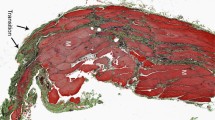Abstract
We report herein our results of routinely performing tension-free repair for midline incisional hernias larger than 3 cm using a woven polypropylene graft between January 1990 and December 1995. Included in this study were 45 patients, 34 (73.1%) of whom had previously undergone a primary repair which had failed. The follow-up period ranged from 3 to 56 months with a mean of 36 months. Only one patient (2.2%) suffered a recurrence of the hernia. Although three (6.6%) developed a wound infection, one (2.2%) developed a wound sinus, and two (4.4%) developed wound seroma, none of these complications required removal of the graft. The findings of this study led us to conclude that Prolene grafts could be used as routine prosthetic material in the repair of incisional hernias. Moreover, during the follow-up period we observed that the modifications we made in the operative technique had a significantly positive effect on the outcome of the patients.
Similar content being viewed by others
References
Bucknall TE, Cox JP, Ellis H (1982) Burst abdomen and incisional hernia: a prospective study of 1129 major laparatomies. Br Med J 284:931–933
Richards PC, Balch CM, Aldrete JS (1983) Abdominal wound closure: a randomized prospective study of 571 patients comparing continuous versus interrupted suture techniques. Ann Surg 197:283–243
Langner S, Christiansen S (1985) Long-term results after incisional hernia repair. Acta Chir Scand 151:217–219
George CD, Ellis H (1986) The results of incisional hernia repair: a twelve year review. Ann R Coll Surg Engl 68:185–187
Red CR, Yader G (1989) Recent trends in the management of incisional herniation. Arch Surg 124:485–488
Adloff M, Arnaud JP (1987) Surgical management of large incisional hernias by an intraperitoneal mersilene mesh and an aponeurotic graft. Surg Gynecol Obstet 165:204–206
Usher FC (1962) Hernia repair with Marlex mesh. Arch Surg 84:73–76
Molloy RG, Moran KT, Waldron RP, Brady MP, Kirwan WO (1991) Massive incisional hernia: abdominal wall replacement with Marlex mesh. Br J Surg 78:242–244
Jones TE, Newel ET, Brubaker RE (1941) The use of an alloy steel wire in the closure of abdominal wounds. Surg Gynecol Obstet 72:1056
Lamant PM, Ellis H (1988) Incisional hernia in re-operated abdominal incisions: an overlooked risk factor. Br J Surg 75:374–376
Fisher JD, Turner FW (1974) Abdominal incisional hernias: a ten-year review. Can J Surg 17:202–204
Maquire RE, Smith PC (1969) Repair of epigastric incisional hernias. Proc Roy Soc Med 62:513–515
Ellis H, Gasraj H, George CD (1983) Incisional hernias: when do they occur? Br J Surg 70:290–291
Geçim IE, Koçak S, Ersöz S, Bumin C, Aribal D (1996) Recurrence after incisional hernia repair results and risk factors. Surg Today 26:607–609
Usher F, Wallace S (1958) Tissue reaction to plastics; a comparison of nylon, Orlon, Dacron, Teflon and Marlex. Arch Surg 76:997–999
Stone HH, Fabian TC, Turkelson ML, Jarkiewicz MJ (1981) Management of acute full-thickness losses of the abdominal wall. Ann Surg 193:612–618
Schneider R, Harrington JL, Granda AM (1979) Marlex mesh in repair of a diaphragmatic defect later into the distal esophagus and stomach. Ann Surg 45:337–339
Kaufman Z, Engelberg M, Zager M (1981) Faecal fistula: a late complication of Marlex mesh repair. Dis Colon Rectum 24:543–544
Larson GM, Harrower HW (1978) Plastic mesh repair of incisional hernias. Am J Surg 135:559–563
Lewis RT (1984) Knitted polypropylene (Marlex) mesh in the repair of incisional hernias. Can J Surg 27:155–157
Burkel WE, Kahn RH (1982) Biocompatibility of prosthetic grafts. In: Stanley JC (ed) Biologic and synthetic vascular prostheses. Grune and Stratton, New York, pp 221–247
Rosenman JE, Pearce WH, Kempczinski RF (1985) Bacterial adherence to vascular grafts after in vitro bacteriemia. J Surg Res 201:705–711
Brown GL, Richardson JD, Malangoni MA, Tobin GR, Ackerman D, Polk HC (1985) Comparison of prosthetic materials for abdominal wall reconstruction in the presence of contamination and infection. Ann Surg 201:705–711
Lamb JP, Vitale T, Kaminski DL (1983) Comparative evaluation of synthetic meshes used for abdominal wall replacement. Surgery 93:643–648
Chan STF, Esufali ST (1986) Extended indications for polypropylene mesh closure of the abdominal wall. Br J Surg 73:3–6
Voyles CR, Richardson JD, Bland KI, Tobin GR, Flint LM, Polk HC (1981) Emergency abdominal wall reconstruction with polypropylene mesh: short-term benefits versus long-term complications. Ann Surg 194:219–223
Bauer JJ, Salky BA, Gelernt IM, Kreel I (1987) Repair of large abdominal wall defects with expanded polytetrafluoroethylene (PTFE). Ann Surg 206:765–769
De Bord JR, Wyffels PL, Marshall JS, Miller G, Marshall WH (1992) Repair of large ventral incisional hernias with expanded polytetrafluoroethylene prosthetic patches. Postgrad Gen Surg 4:156–160
Author information
Authors and Affiliations
Rights and permissions
About this article
Cite this article
Türkçapar, A.G., Yerdel, M.A., Aydinuraz, K. et al. Repair of midline incisional hernias using polypropylene grafts. Surg Today 28, 59–63 (1998). https://doi.org/10.1007/BF02483609
Received:
Accepted:
Issue Date:
DOI: https://doi.org/10.1007/BF02483609



